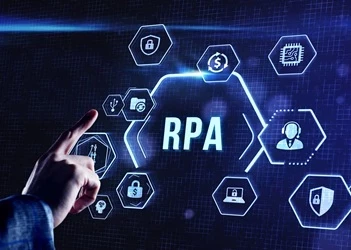In the words of Barry Matthews from ISG, 'Last year’s IAFS was all about how the robots were coming... this year, the robots are here!’ But how are these robots shaping our world? How are they implemented? And how do they help businesses expand?
The very first session was a wake up call to everyone who had let themselves think that a long history gave their business some sort of innate stability. Hosted by UiPath’s Guy Kirkwood, Megan Caywood (Starling Bank) and Thierry Derungs (BNP Paribas) took to the stage discussing how their relationships with technology were throwing up challenges and opportunities from their differing perspectives.
Megan told us that the 2008 crash had come at precisely the wrong time - putting innovation onto a back burner for financial institutions struggling to survive and facing a wave of new regulation. ‘We don’t have an IT team,’ she said, ‘we are an IT company. We have a lot of liberty to do things differently - and faster than anyone doing things the old way through legacy systems.’
Speaking of legacy, Thierry’s observation was that existing systems take a long time to change, so BNP’s approach in a time of growth is different: ‘We are in a growing area so we are using RPA as cost containment. We automate basic process so we don’t increase staff at same rate we are increasing business.’
The game changing approach of Starling, however, got people sitting up, particularly when she described an ultra-streamlined way of opening a bank account, and a fully-automated customer migration from one bank to another. Thierry gave the startling statistic that across BNP’s operations there were 3,000 new compliance rules each month, leading the conversation to the point at which it was agreed robots were ideally deployed to keep Financial Services within the rules - and maybe they will soon be the only the only realistic option for doing so.
Guy brought in some of his own thoughts about how technology is ushering in a cultural change in the workplace. He observed that leaders are demanding AI, even if they aren’t entirely sure what it means. ‘Blockchain, too,’ said Thierry, which got a laugh and raised the prospect that there is a technological divide between the people who understand these new concepts fully, and those who just want the benefits they’ve heard about.
Are their hopes realistic? Or are too many people believing hype? The benefits, agreed all three speakers, were tangible: for Megan, technology enables companies to move faster at lower cost to create a better customer experience: making things intuitive and simple to reduce anxiety.
Thierry’s take was slightly different: efficiency and accuracy, fraud prevention and security were the big takeaways for BNP.
Guy had an eye on the cultural changes technology is ushering in: if the aim of RPA is to reduce headcount, it’s failing, as employee engagement is going up - ‘as we have seen time and time and time again.’ Enough of the threats of job losses; Guy says we are embarking on a new world in which the value of human capital is much higher.
Can't make it to the event? All the sessions are available on demand here.
As ever at these events, you run into all kinds of interesting people and have conversations that open your eyes to possibilities.
In the queue for coffee, I asked a number of people variations on the question: ‘What’s better, startups with a bedrock of tech, or an established business with a load of legacy that the new tech has to work with?’
Quite a few delegates agreed that the idea of starting from scratch was attractive, which suggests that anything vendors can do to reassure people their kit is able to deliver start-up style gains of efficiency whilst coping with legacy systems. Personal opinion: the bigger the business, the more likely they are to seek partnerships with smaller organisations, if not set up semi-autonomous teams to tackle a particular aspect of their operations. be prepared for that chain of command to evolve into an ecosystem of responsibilities...
I also spoke to Wayne Butterfield from ISG, who is an early adopter’s early adopter: ‘RPA is something I first deployed in 2010, and I’ve been talking about it in public since 2012. At the first SSON event I attended, I was the only one talking about it. My job is to be one step ahead, so while others are getting with the RPA programme, I’m looking at the rest of the ecosystem of complimentary technologies.’
Outside, the planes flying past Buckingham Palace for the RAF’s 100th birthday were just visible through the Hurlingham Club’s lush trees. A great symbol of technology transforming our lives, I thought as the Red Arrows followed up the end of the display. I fell to chatting with a Hurlingham member who had once been PA to one of the Executives at Concorde. ‘I’ve signed the Official Secrets Act,’ she teased, ‘so I can’t possibly tell you most of what I know. But I can tell you how a jet engine works if you like.’
























